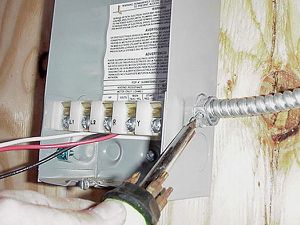Wiring a Water Well Pump Controller and Switch |
|
To wire up a pump in a water well is a relatively small project you can do yourself (assuming you are the homeowner and local codes allow for this). Many well drillers are not licensed and finding a licensed electrician can add unnecessary time and costs to the job. |
 |
|
Items needed:
Screw driver |
Safety Suggestions and Tips
Be sure power is off
Let electrician make connections in breaker box Use anti-oxidant on connection due to moisture |
Level of difficulty
 Time Required: 4 hour
|
|
|
|
Steps |
|
|
|
|
Step 1: The controller box needs to be mounted, typically near the pressure tank. The box is screwed to the wall as a surface mount. Choose an interior location, away from sunlight and not in a damp place, such as a well pit. |
|
Step 2: You will need to run power from the breaker box to the pressure switch. Here we are using two-wire, plus ground. |
|
Step 3: The switch is fed from the left and a three-wire cable leads to the controller box. |
|
Step 4: Because this application is situated in a barn area, we have chosen to use BX rather than Romex cable. Add the appropriate connectors for BX or Romex to the switch. Cut and strip the leads and attach to the switch. (Note that rodents can easily chew through the white plastic, so we have used BX in this installation.) Be sure to check with local building codes in deciding between type of cable and possible need for conduit. And don't forget - Be sure the power is OFF! |
|
Step 5: You will need to run power from the pressure switch on the pressure tank to the controller. This contains the starting relay and capacitors. This needs to be a three-wire, plus ground cable. First, cut the cable to length. Install the anti-short or insulated bushing to wrap the ground around the cable. |
|
|
Step 6: Before you connect the wires, it is advisable to avoid corrosion by using an anti-oxidant on the wires. |
|
|
Step 7: Use anti-oxidant on all wires including the ground. In our installation this box is within sight of the breaker panel and there is no need for a separate disconnect switch. |
|
|
Step 8: The cable from the pump typically has four strands and is cased in a heavy shielding. (Note that the conduit is not shown in this picture.) |
|
|
Step 9: Typical wire strippers will not work and though not very elegant you can use a knife to carefully cut back and remove the shielding. You can then pull and expose the wire |
|
|
Step 10: Cable stapes for pump wire are much wider than normal staples. |
|
|
Step 11: Attach the wires as per diagram, again using anti-oxidant. In this article we are focusing on the interior connection. If you need an exterior waterproof connection, click here. |
|
|
Step 12: Before you fire the pump up with the power, check out the Start-up Procedures Manual from the Submersible Water Pump Association. If you encounter problems, check the links below for help or e-mail us and we'll get an answer. |
|
Reference: Before you get started on the wiring you should see the wiring diagram and guide from PumpWorld where you can also select and order your pump on-line. You might also want to read articles from PumpsOnLine. You should also note that there are magazine devoted specifically to well, such as the Well Water Journal from the National Ground Water Association. Be sure to check your local building code such as those from Oregon and New Hampshire. |
|
|